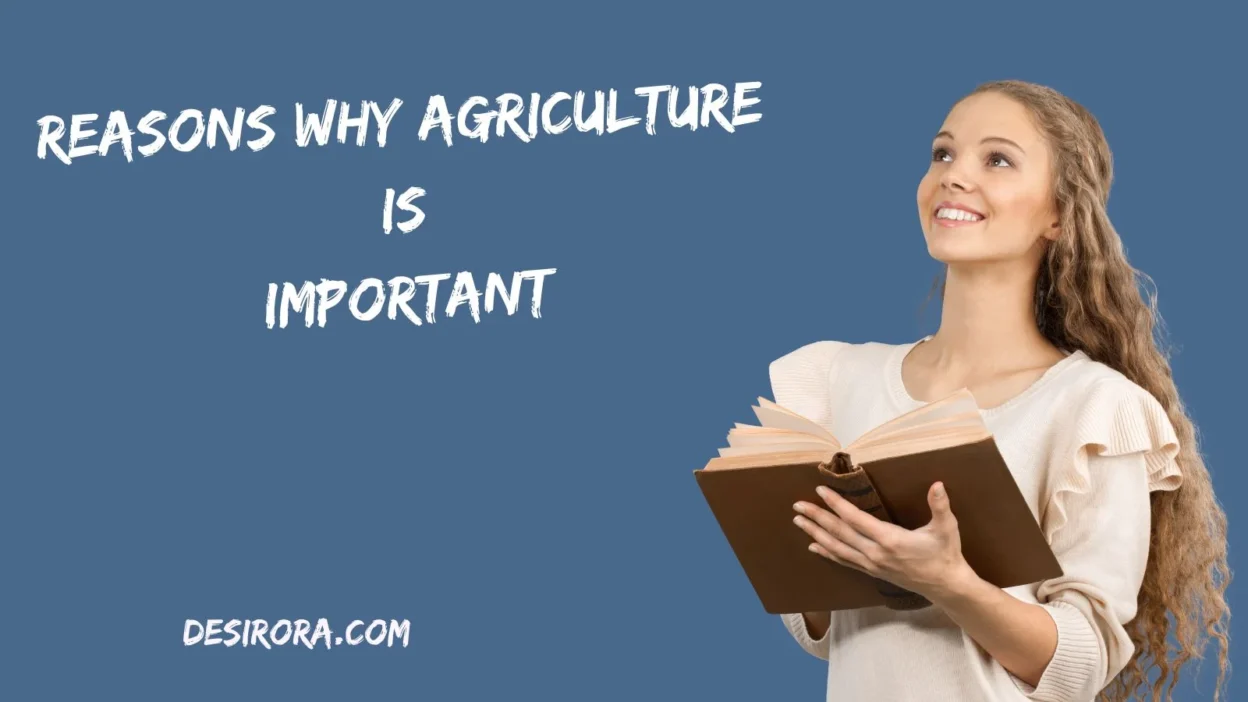Agriculture touches nearly every corner of our lives. From the food on your plate to the clothes you wear, agriculture plays a foundational role.
Let’s dig into why agriculture truly matters — in practical, down-to-earth ways.
The Role of Agriculture in Human Survival
At its core, agriculture is about converting nature’s gifts—sunlight, soil, water—into sustenance. Without farming, raising animals, or growing plants, human societies would revert to hunting and gathering. That worked for a time, but it’s insufficient for a growing global population.
- Basic sustenance: Cereals, vegetables, fruits, protein crops—all come from fields and farms.
- Raw materials: Many non-food items begin in agriculture: cotton for textiles, natural rubber, medicinal plants.
- Foundation for civilizations: Historical civilizations flourished where agriculture thrived (e.g. Mesopotamia, Nile delta).
In short: agriculture is the bedrock of civilization.
Food Security and Nutrition
One of the most compelling “reasons agriculture is important” is food security.
Ensuring Enough Food for All
When farming is productive and sustainable, it ensures availability—there’s enough food. It also helps with accessibility—people can afford or reach the food. And it addresses utilization—ensuring nutritious, safe food.
If agriculture fails—due to climate shocks, pests, or mismanagement—hunger and malnutrition rise.
Nutrition and Dietary Diversity
Growing a mix of crops (fruits, vegetables, legumes) boosts nutrition. Monoculture (growing just one crop) can satisfy calories but may lack essential vitamins, minerals, and protein.
Example: In a region that grows only maize, people might get too much starch but lack vitamin A. Adding sweet potato, leafy greens, pulses fixes that gap.
Resilience and Local Food Systems
Relying on imported food can leave a region vulnerable if global supply chains break. Having strong local agriculture makes communities resilient—food is grown nearby, supply chains shorten.
Economic Significance and Employment
Agriculture is far more than planting and harvesting. It’s a major economic engine — especially in developing countries.
Jobs & Livelihoods
- A large share of rural populations depends directly on farming (smallholders, laborers).
- Supporting industries: fertilizers, machinery, seed companies, transport, processing, packaging.
- Agri-businesses stimulate jobs in rural and urban areas.
GDP & National Prosperity
In many nations, agriculture contributes significantly to GDP (gross domestic product). A thriving agricultural sector provides:
- Exports (cash crops, commodities) that bring foreign currency
- Backward and forward linkages to industry (processing, storage, transport)
- Rural infrastructure development (roads, irrigation, electricity)
Income and Poverty Reduction
When farmers get fair prices, access to credit, technology, and markets, they boost their income. That reduces poverty, especially in rural areas where poverty tends to be highest.
Case Study: In some African countries, introducing small-scale irrigation increased yields by 2–3x for many farmers. That additional income allowed them to send kids to school, invest in health, diversify livelihoods.
Environmental Benefits and Ecosystem Services
It may surprise some, but agriculture—when done well—offers ecosystem services and environmental benefits. That flips the usual narrative that farming only degrades the environment.
Carbon Sequestration & Soil Health
- Some agricultural practices (agroforestry, cover cropping, conservation tillage) capture carbon from the atmosphere and store it in soil.
- Healthy soils retain more water, resist erosion, and maintain fertility.
Biodiversity & Habitat Support
Diverse farming—polycultures, agroecological methods—can support insects, birds, beneficial predators, and soil microbes. In effect, farms can be part of the habitat mosaic rather than ecological wastelands.
Watershed Protection & Water Regulation
Well-managed landscapes control water runoff, reduce flooding, recharge groundwater, filter pollutants. Farms with buffer strips and contour planting help reduce soil erosion and sedimentation in rivers.
Renewable Energy & Waste Recycling
Agriculture can produce bioenergy (biogas, biomass) and reuse organic waste (composting, manure). That reduces reliance on fossil fuels and closes nutrient loops.
Cultural, Social, and Rural Development
Beyond economics and environment, agriculture shapes communities, traditions, and social fabric.
Cultural Identity & Heritage
In many regions, farming is part of cultural identity—festivals, traditional knowledge, heirloom varieties, rituals linked to planting/harvest. Losing agriculture often erodes local heritage.
Food Sovereignty & Local Control
Having your own land and food system gives communities autonomy. It’s not just food provision, it’s control over what and how you grow.
Rural Stability & Migration
When rural agriculture is viable, people don’t feel forced to migrate to cities. That helps reduce pressures on urban infrastructure, slums, unemployment in cities.
Women, Youth & Social Equity
Often, women and youth play central roles in farm operations. Supporting equitable access to land, education, credit, technology empowers these groups and fosters inclusive growth.
Technological Innovation in Agriculture
Agriculture is innovating rapidly. Modern tools and methods make farming smarter, more efficient, and more sustainable.
Precision Farming & Digital Tools
Using sensors, drones, satellite imagery, and AI modeling, farmers can monitor soil moisture, pest outbreaks, nutrition deficits. This precision reduces waste (water, fertilizer) and increases yield.
Biotechnology & Crop Improvement
Plant breeding, GMO (where allowed), gene editing, improved seed varieties yield crops that resist drought, pests, or disease.
Mechanization & Automation
Tractors, harvesters, robotics—these reduce drudgery, speed operations, and make large-scale farming more viable. Especially for aging rural populations, mechanization helps maintain productivity.
Smart Irrigation & Water Management
Drip irrigation, micro-sprinklers, sensor-based watering minimize water use while maximizing crop growth. In water-scarce areas, these innovations are game changers.
Challenges, Risks, and the Path Forward
No sector is perfect. Agriculture faces many obstacles—but the path forward is rich with opportunity.
Climate Change & Extreme Weather
Droughts, floods, shifts in growing seasons, pests moving to new zones—all threaten agriculture. Adaptive methods (drought-tolerant crops, resilient systems) are essential.
Land Degradation, Soil Erosion & Salinization
Mismanagement (overuse of chemicals, mono-cropping, deforestation) can degrade soils and reduce fertility. Restorative practices are vital.
Water Scarcity & Pollution
Agriculture uses huge shares of freshwater. Uneven use, inefficient irrigation, runoff of fertilizers and pesticides threaten water quality and quantity.
Market Access & Price Volatility
Farmers often lack access to markets, get low returns, or face price fluctuations. Infrastructure (roads, storage, cold chains), cooperatives, and fair trade systems help.
Resource and Input Inequality
Smallholder farmers may struggle with access to credit, quality seed, machinery, extension services. Bridging that gap is central to inclusive agricultural development.
Institutional & Policy Gaps
Governments must support agriculture via land rights, subsidies (carefully designed), research, extension, insurance schemes, and regulation to protect environment and human health.
Synonym Table & Terminology Help
| Word / Phrase | Synonyms / Related Terms |
| Agriculture | Farming, cultivation, agronomy, husbandry |
| Crop yield | Harvest output, productivity |
| Sustainable | Eco-friendly, green, resilient, regenerative |
| Food security | Nutrition security, food availability |
| Ecosystem services | Environmental benefits, ecological functions |
| Mechanization | Automation, mechanised farming |
| Precision farming | Smart agriculture, digital farming, site-specific management |
Grammar Note: Active Voice vs Passive Voice
- Active: Farmers use drip irrigation to conserve water.
- Passive: Water is conserved by the use of drip irrigation by farmers.
Active voice is generally clearer and more direct. Use it when possible. Use passive only when the doer is unimportant or unknown.
Real-Life Examples & Case Studies
- In India, the Green Revolution in the 1960s drastically increased wheat and rice yields using improved seeds, fertilizers, and irrigation. That prevented famine.
- In Brazil, agroforestry systems (trees + crops) are restoring degraded lands, capturing carbon, boosting incomes for rural communities.
- In The Netherlands, high-tech greenhouse farming yields enormous production on small land area using sensors, hydroponics, and automation.
- In Kenya, smallholders with mobile-based weather prediction services adjust planting timing and reduce crop failure rates.
These examples show how agriculture adapts across climate zones, scales, and technologies.
Conclusion
Agriculture is far more than planting seeds. It’s the backbone of human civilization—feeding billions, supporting economies, shaping landscapes, nurturing culture. Its value spans nutrition, environment, socioeconomics, and innovation. But agriculture also faces serious challenges: climate change, degraded soils, inequity in access.
The path forward lies in sustainable, inclusive, innovative agriculture — blending traditional wisdom with modern technologies. When we invest in farming, support rural communities, protect ecosystems, and empower smallholders, we support not just food systems but the very future of humanity.
FAQs
Q: Why is agriculture considered so vital to food security?
A: Because agriculture produces the raw food supply, determines availability, accessibility, and influences nutrition quality. Without it, societies lack stable food systems.
Q: Can agriculture be environmentally friendly?
A: Absolutely. Practices like agroforestry, cover cropping, conservation tillage, organic farming, and integrated pest management reduce negative impacts and enhance ecosystem services.
Q: How does agriculture contribute to the economy?
A: Through employment (farmers, laborers, agri-businesses), GDP contributions, export earnings, industrial linkages, rural development, poverty reduction.
Q: What role does technology play in modern agriculture?
A: Technology increases precision (less waste), improves yields (better seeds, sensors), automates labor, helps adapt to climate changes, and monitors resource use.
Q: What challenges does agriculture face currently?
A: Key challenges include climate change, water scarcity, soil degradation, market access, resource inequality, policy gaps, and price volatility.

Aldous Huxley was a visionary writer and philosopher whose works explored human nature, consciousness, and the future of society. His ideas continue to challenge minds and inspire generations.



